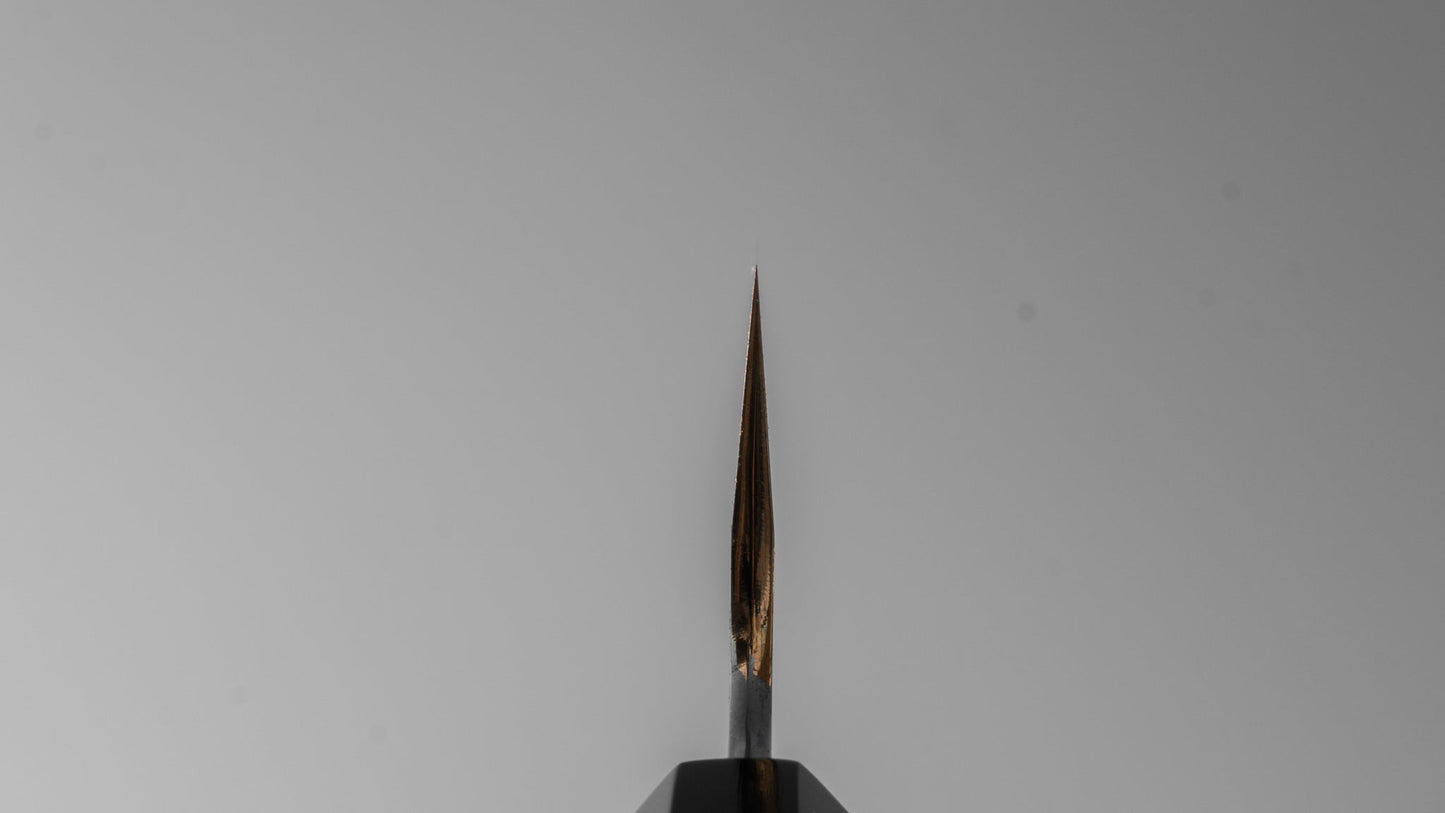Oboro White #2 Mizu Honyaki Gyuto 240mm Taihei Quince/ Ebony Handle (#001)
Oboro White #2 Mizu Honyaki Gyuto 240mm Taihei Quince/ Ebony Handle (#001)
SKU:dta-010-fa240
Couldn't load pickup availability
It takes 1-5 days to ship out
Oboro
All craftsman work on limited time and budget, this is especially true of kitchen knives because of the tools that are needed to be used. As a result, only 70-80% of a craftsman’s ability is used on most of their work, to match the budget and price of a knife.
The Oboro project was founded on the 4 important elements of Sakai’s fine kitchen knife making. These are a blacksmith, a sharpener, a handle maker and a finisher. For this project, we gave each craftsman enough time and budget to be able to perform to their maximum ability.
Because of the time required to produce each knife, only a few will be available each season, and each batch will be made differently.
The first batch of 2019 winter is using Yasuki white #2 steel, water quenched in winter when the water is cold enough to make the best knife. The heel height is 50mm+, which is higher than most Kikuchiyo knives and a specially designed Hamon has been employed, only for Oboro. These knives are polished and sharpened by only the most talented of Sakai’s kitchen knife sharpeners, Kambei. The handle was custom crafted by Taihei only for Oboro, with fine polished ebony and quince, and a double buffalo horn. Finally these knives were finished by Kakuyoshi. Only two knives are available.
Blacksmith: Kikuchiyo
In the early 2000s, Kikuchiyo was invited by master craftsman of Sakai to join them as a blacksmith. The art of blacksmithing is physical, the rough working environment of fire and iron takes a toll on the body and many of the masters' abilities begin to wane in their forties and fifties. As Kikuchiyo started earlier in life, he has gained most of the knowledge and skill of fine forging and quenching, before his physical abilities deteriorate.
Kikuchiyo proactively experimented with new steels not generally used by Sakai’s blacksmith, steels such as stainless. His experience and skill have made his Ginsan (Silver 3) knives popular among Japanese cuisine chef’s, many stating “If you use Kikuchiyo’s Ginsan once, you will never replace it”.
Kikuchiyo is also known for fine Honyaki quenching, beautiful Hamon and the correct hardness and gumminess are only achievable by experienced masters achieving the correct temperature. His Honyaki is supported by many of Sakai’s sharpeners and finishers, professionals who know what makes a good kitchen knife.
When Kikuchiyo joined as a blacksmith, he dreamed of success and becoming a great man. He continues to develop his skills as a craftsman, modelling each of his knives on the image of his master’s forge.
Sharpener: Kambei
Kambei is more than a master sharpener, his work extends the individuality of a blacksmith and increases its value and performance, giving a great experience to the user.
In the past, the main focus of the sharpener was just to make an edge sharp, the beauty and function of specific shapes were not as important as today. Kambei took sharpening to the next level, encompassing shape and sharpness, polishing choil and spine nicely whilst maintaining a thin edge and accurate Shinogi line, for both single and double bevel knives.
This is a challenging technique as forged steels have many shapes and characteristics, Kambei is probably one of the only sharpeners in the world able to consistently sharpen forged knives to this standard in.
Kambei is respected and supported by many blacksmiths and knife finishers in Japan. Although he has been working since the 1980s, teaching his own techniques to many famous sharpeners and is considered a “master” by many, he still feels he is proving his skills and making new techniques, each knife is a new challenge he dedicates himself towards.
Handle Maker: Taihei
Many people have strict standards when selecting a handle, it is the only component we physically engage with a knife, the only part that touches our skin. Others overlook the handle of a kitchen knife as just a small “part” and do not pay close enough attention. Taihei however, a 3rd generation handle maker, shows a strong commitment to his craft.
When he was a child, Taihei remembers his grandfather crafting knife handles of timber and buffalo horn by hand, these fond memories helped him to decide to carry on the tradition from his father to the next generation, the year was 1992.
As the handle is not considered the main part of a kitchen knife, most manufacturers cut costs by having the ferrule made at a different location, then joining the two parts and shaping the handle by machine. Taihei however, still cuts each part of the handle by hand from solid materials, understanding the differences between each piece of wood and horn. This knowledge and skill make Taihei’s handles more durable than mass-produced models as he is making each piece differently to suit the materials in his hand.
As well as making traditional Ho magnolia wood handles, Taihei also challenges his work with many different timbers from all over the world. Each timber has a different weight, density, fineness and character, all important to consider when crafting each piece. He says, “if people have been using that wood for a long time, there is a reason that you cannot understand it within 10 or 20 years”. Taihei still respects tradition, but challenges with new materials and design, focusing on looks and functionality.
Finisher: Kakuyoshi
Sakai’s kitchen knives are crafted in 3 main stages. A blacksmith forges and quenches the steel, then a specialist sharpener sharpens the knife, then a handle maker will make a handle. Finally, a finisher assembles all of these elements, to make them work perfectly together.
Finishers will design a rough sketch of a knife, fit the handle, and then make a final sharpening on a stone. These final steps by a finisher are the determining factors of the quality of Sakai’s kitchen knives.
When Kakuyoshi was growing up, he was unfamiliar with the kitchen knife industry but decided to learn the craft. At the beginning of his career, he saw the antiquated way in which the industry worked, seeing a gap between the seller and maker, and how the craftsman was used by makers and sellers.
Whilst training in knife polishing under a sharpener, Kakuyoshi started to understand the pure attitude of knife makers and their huge levels of knowledge and skill only created by their long experience. Here he decided to make kitchen knives that worked with their abilities. These knives came from his ideas, experience and knowledge, the kitchen knives he created are what made “Sakai Kitchen Knives famous and brought them to the next level. He continues to make new knives that bring tradition to the next generation with modern technique.
Detailed Spec
Brand: Oboro
Smith: Kikuchiyo
Producing Area: Sakai-Osaka/ Japan
Profile: Gyuto
Size: 240mm
Steel Type: Carbon Steel
Steel: Honyaki Yasuki White (Shirogami) #2
Handle: Taihei Quince/ Ebony & Double Buffalo Horn Ferrule Octagonal
Total Length: 390mm
Edge Length: 226mm
Handle to Tip Length: 246mm
Blade Height: 52mm
Thickness: 3.2mm
Handle Length: 148mm
Weight: 220g
Hand Orientation: Ambidextrous
Sharpener: Kambei
Handle Maker: Taihei
Finisher: Kakuyoshi
Update: July 18, 2025
* Measurement and photos are from sample I picked up randomly, please understand that each item(s) has unique profile and colur because of handmade and natural materials.
*Please understand that we are supplying as wholesale and selling it at the website at the same time. If you purchase item(s) after supplied to the retail shop, this might be out of stock.
Share


































